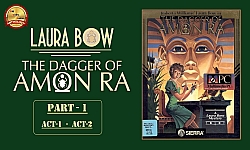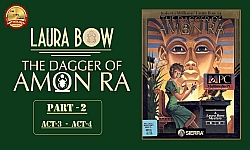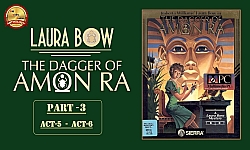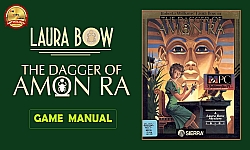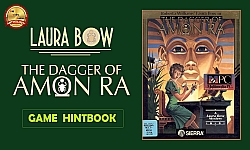|
Release: 1992 (floppy disk), 1993 (CD-ROM).
Developer: Sierra On-Line, Inc.
Publisher: Sierra On-Line, Inc.
Genre: Adventure.
Directors: Bruce Balfour, Bill Davis (creative).
Writer: Josh Mandel.
Producer: Bruce Balfour.
Design: Bruce Balfour.
Programmer: Brian K. Hughes.
Artist: Cheryl Sweeney.
Composers: Chris Braymen, Mark Seibert.
Music Director: Mark Seibert.
Additional Music and Sound Effects: Orpheus Hanley, Rudy Helm, Dan Kehler, and Susan Kehler (Vocalist for "The Archaeologist Song").
Music for ''The Archeologist Song'': Christopher Braymen.
Lyrics for ''The Archeologist Song'': Bruce J. Balfour.
Engine: SCI 1.1.
Platforms: MS-DOS, Windows.
Mode: Single-player.
Distributed on: (6) 3.5" floppy disks and CD-ROM.
The Dagger of Amon Ra (also known as Laura Bow II: The Dagger of Amon Ra or Roberta Williams' Laura Bow in The Dagger of Amon Ra) is a computer adventure
game developed and published by Sierra On-Line in 1992. The game is the second and final installment in the Laura Bow Mystery series of adventure games,
the first of which was The Colonel's Bequest. The sequel, unlike the first game, was not written or created by Roberta Williams. Using 8-bit color and a
point-and-click interface, The Dagger of Amon Ra was developed using Sierra's Creative Interpreter (SCI1.1).
The game is set primarily in a museum circa of 1926, and it reflects the Egyptology craze of the period. The protagonist is Laura Bow (a pun on Clara Bow),
a Southern belle who has just graduated from Tulane University and moved to New York City, where she has landed a job at a prestigious newspaper. For her
first assignment, she is asked to write a straightforward, lightweight story on a benefit held at a local museum to celebrate their new Egyptian exhibit.
When a murder occurs during the party, however, she is locked inside with all of the other suspects. As other guests begin dying one by one, Laura must
solve the numerous crimes occurring before the culprits escape or kill her.
The Laura Bow games were distinctive in that they required some actual logical detective work on the part of the player; for the most part, though, the
puzzles were of the typical variety of inventory and environment interaction (and frequent, often unexpected, player character death) found in most Sierra
adventures.
The identity of the murderer is not automatically revealed at the end of the game. Instead, the player is asked a series of a questions, ostensibly by the
police, to prove that Laura had solved the crimes and discovered the secrets of the other suspects. If the questions are answered incorrectly, the coroner
will give a hint to point the player towards the path that would have revealed the correct answer in subsequent playing of the games. The ending of the game
can change depending on the answers given to the questions, most notably in that Laura can be killed if the player doesn't know the identity of the main
murderer. Some have complained about this approach, since it can require replaying the game from nearly the beginning to reach the optimal ending.
This is the first game by Roberta Williams to feature blood and violence in the Leyendecker Museum including showing peoples bodies being murdered which was
unusual during the time she made family friendly PC games.
The visual style of the game is based on on the artwork of J. C. Leyendecker. In addition, the cover for the game is based on Leyendecker's cover for the 18
March 1905 issue of the Saturday Evening Post.
Pippin Carter, one of the characters of the game, is a parody of a real archaeologist named Howard Carter.
The exterior of the 'Leyendecker Museum' of the game is based on the National Museum of Natural History in Washington, D.C.
Roberta Williams, creator of Laura Bow, served as creative consultant, while Bruce Balfour wrote and designed the game.
The last reference to the series was in a nod in Gabriel Knight: Sins of the Fathers (1993), where an octogenarian Laura Dorian is scheduled to speak at a
New Orleans university.
The game incorrectly portrays 20th-century Egyptians believing in ancient Egyptian gods, being sensitive about their "ancestors" and bearing names of gods
ands pharaohs (like Rameses Najeer). In reality, modern Egyptians are not culturally or emotionally connected to ancient Egyptians but are part of the Arabic
culture. Revivals of ancient Egyptian religion are much more recent.
|
